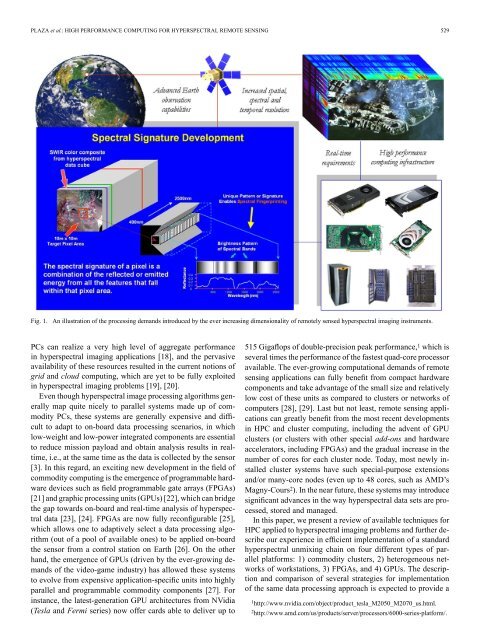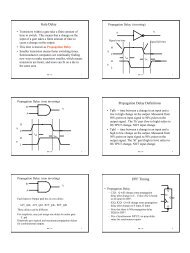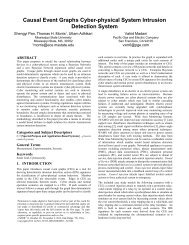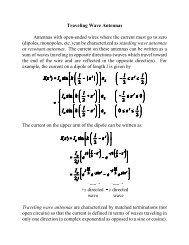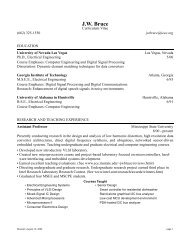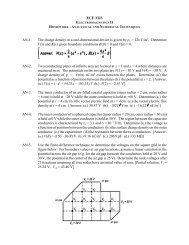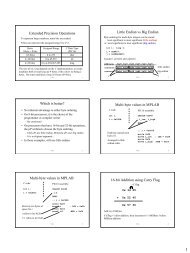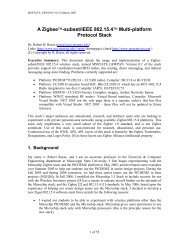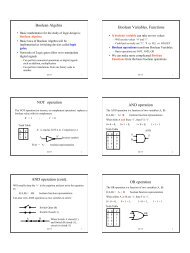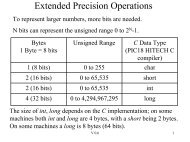High Performance Computing for Hyperspectral ... - IEEE Xplore
High Performance Computing for Hyperspectral ... - IEEE Xplore
High Performance Computing for Hyperspectral ... - IEEE Xplore
You also want an ePaper? Increase the reach of your titles
YUMPU automatically turns print PDFs into web optimized ePapers that Google loves.
PLAZA et al.: HIGH PERFORMANCE COMPUTING FOR HYPERSPECTRAL REMOTE SENSING 529<br />
Fig. 1.<br />
An illustration of the processing demands introduced by the ever increasing dimensionality of remotely sensed hyperspectral imaging instruments.<br />
PCs can realize a very high level of aggregate per<strong>for</strong>mance<br />
in hyperspectral imaging applications [18], and the pervasive<br />
availability of these resources resulted in the current notions of<br />
grid and cloud computing, which are yet to be fully exploited<br />
in hyperspectral imaging problems [19], [20].<br />
Even though hyperspectral image processing algorithms generally<br />
map quite nicely to parallel systems made up of commodity<br />
PCs, these systems are generally expensive and difficult<br />
to adapt to on-board data processing scenarios, in which<br />
low-weight and low-power integrated components are essential<br />
to reduce mission payload and obtain analysis results in realtime,<br />
i.e., at the same time as the data is collected by the sensor<br />
[3]. In this regard, an exciting new development in the field of<br />
commodity computing is the emergence of programmable hardware<br />
devices such as field programmable gate arrays (FPGAs)<br />
[21] and graphic processing units (GPUs) [22], which can bridge<br />
the gap towards on-board and real-time analysis of hyperspectral<br />
data [23], [24]. FPGAs are now fully reconfigurable [25],<br />
which allows one to adaptively select a data processing algorithm<br />
(out of a pool of available ones) to be applied on-board<br />
the sensor from a control station on Earth [26]. On the other<br />
hand, the emergence of GPUs (driven by the ever-growing demands<br />
of the video-game industry) has allowed these systems<br />
to evolve from expensive application-specific units into highly<br />
parallel and programmable commodity components [27]. For<br />
instance, the latest-generation GPU architectures from NVidia<br />
(Tesla and Fermi series) now offer cards able to deliver up to<br />
515 Gigaflops of double-precision peak per<strong>for</strong>mance, 1 which is<br />
several times the per<strong>for</strong>mance of the fastest quad-core processor<br />
available. The ever-growing computational demands of remote<br />
sensing applications can fully benefit from compact hardware<br />
components and take advantage of the small size and relatively<br />
low cost of these units as compared to clusters or networks of<br />
computers [28], [29]. Last but not least, remote sensing applications<br />
can greatly benefit from the most recent developments<br />
in HPC and cluster computing, including the advent of GPU<br />
clusters (or clusters with other special add-ons and hardware<br />
accelerators, including FPGAs) and the gradual increase in the<br />
number of cores <strong>for</strong> each cluster node. Today, most newly installed<br />
cluster systems have such special-purpose extensions<br />
and/or many-core nodes (even up to 48 cores, such as AMD’s<br />
Magny-Cours 2 ). In the near future, these systems may introduce<br />
significant advances in the way hyperspectral data sets are processed,<br />
stored and managed.<br />
In this paper, we present a review of available techniques <strong>for</strong><br />
HPC applied to hyperspectral imaging problems and further describe<br />
our experience in efficient implementation of a standard<br />
hyperspectral unmixing chain on four different types of parallel<br />
plat<strong>for</strong>ms: 1) commodity clusters, 2) heterogeneous networks<br />
of workstations, 3) FPGAs, and 4) GPUs. The description<br />
and comparison of several strategies <strong>for</strong> implementation<br />
of the same data processing approach is expected to provide a<br />
1 http://www.nvidia.com/object/product_tesla_M2050_M2070_us.html.<br />
2 http://www.amd.com/us/products/server/processors/6000-series-plat<strong>for</strong>m/.


